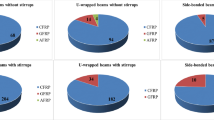Abstract
Delamination between any two plies is an important damage commonly seen in composite structures. It may initiate and grow in the composite laminates for different loading conditions, and it may finally lead to failure of the component under the cyclic loading. Therefore, fatigue life prediction in these structures is important to avoid the effects of delaminations in economic and safety considerations. The usage of artificial neural network (ANN) in estimating fatigue failure in composites with delaminations would be high. In this work, experimental fatigue data were obtained for glass fiber-reinforced composite beams with and without delaminations. The experimental results were used to train and test the neural network. Finally, ANN was found to be accurate tool for fatigue life estimation for composite materials with delaminations as it produces reasonably good fatigue life prediction for delaminated composites.















Similar content being viewed by others
References
Senthilkumar M, Sreekanth TG, Manikanta Reddy S. Polymers and Polymer Composites 2020;9:0967391120921701.
S.M. Abhilash, P.K, Sahoo, B. Raghuvir Pai. International Journal of Electrical, Electronics and Computer Systems 2014; 54:2347.
Huston RJ. International Journal of Pressure Vessels and Piping 1994;59:131.
Adarsh DK, Andrews R, Banuchandar M, Manikandan R. Journal of Basic and Applied Engineering Research 2014;1:1.
Micelli F, Nanni A. Mechanics of Composite Materials. 2003;39:293.
Bhanage A, Padmanabhan K. ARPN Journal of Engineering and Applied Sciences 2014;9:196.
J. C. Newman. Journal of Engineering Materials and Technology1995. 117:433.
Kennedy CR, Leen SB, Brádaigh CM. Proceedings of the Institution of Mechanical Engineers, Part L: Journal of Materials: Design and Applications. 2012;226:203.
Livingstone DJ, editor. Artificial Neural Networks: Methods and Applications. Totowa: Humana Press; 2008.
Ganguly, S., Ojo, O.A., Chattopadhyay, P.P. and Roy, D. 2012. Journal of Materials Science Research, 1:59.
Kundu, M., Ganguly, S., Datta, S. and Chattopadhyay, P.P. 2009. Materials and Manufacturing Processes, 24:169.
Al-Assaf Y, El Kadi H. Composite Structures 2001;53:65.
Al-Assadi M, El Kadi H, Deiab IM. Applied Composite Materials 2010;17:1.
Shankara DR, Kumar PK. i-Manager's Journal on Material Science 20171;5:47.
Alemu HZ, Wu W, Zhao J. Symmetry 2018;10:525.
Gope D, Gope PC, Thakur A, Yadav A. Applied Soft Computing 2015;30:514.
Elman J L. Cognitive Science 1990; 14:179.
Kumar M S, and Vijayarangan S, Materials Science 2007; 13:141.
Acknowledgements
The authors would like to thank the Management and Principal of PSG college of Technology, India, for their extensive support for carrying out the research.
Author information
Authors and Affiliations
Corresponding author
Additional information
Publisher's Note
Springer Nature remains neutral with regard to jurisdictional claims in published maps and institutional affiliations.
Rights and permissions
About this article
Cite this article
Sreekanth, T.G., Senthilkumar, M. & Reddy, S.M. Fatigue Life Evaluation of Delaminated GFRP Laminates Using Artificial Neural Networks. Trans Indian Inst Met 74, 1439–1445 (2021). https://doi.org/10.1007/s12666-021-02234-5
Received:
Accepted:
Published:
Issue Date:
DOI: https://doi.org/10.1007/s12666-021-02234-5




